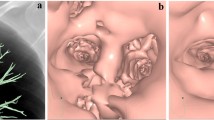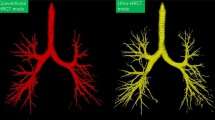Abstract
The purpose of this study was to evaluate the scope of sub-millimeter collimation reconstruction parameters using 16-row computer tomography and ECG triggering on image quality in virtual bronchoscopy. Thirty-two patients (5 women, 27 men, mean age 66.6±1.4) who had been admitted for coronary artery bypass graft surgery underwent CT examination of the thorax (Sensation 16, Siemens, Inc., Forchheim, Germany). All patients were examined with 16×0.75-mm collimation. Image reconstruction was performed for two groups. In group A (n=32), slice thickness of 1.5 mm and an overlap of 0.75 mm were used. In group B (n=32), slice thickness of 0.75 mm and an overlap of 0.4 mm were applied. Retrospective ECG triggering was performed in all patients. The maximum order of recognizable bronchi was determined in each data set. In addition to assessing the maximum order of bronchial bifurcation, bronchial diameter was determined in truly perpendicular sections in each patient. For every segment proximal to a bifurcation, image quality was subjectively graded as poor (grade 1), moderate (grade 2) or good (grade 3). The observers were asked to identify the minimum cardiac movement ECG-triggered image sets assuming that they would be of better quality than the maximum cardiac movement ECG-triggered image sets. The Mann-Whitney U-test and the Fisher’s Exact Test were used for statistical evaluation. In group A, a mean of 4.8±0.2 bifurcations was ascertained vs. 6.5±0.3 bifurcations in group B [P<0.0003]. For bronchial diameters in group A, a mean of 7.5±0.4 mm was determined vs. 4.6±0.4 mm in group B [P<0.0001]. In group B, two independent radiologists observed a significant shift to better image quality in all segments evaluated [P<0.006 to P<0.000001]. Motion artifacts were judged as being significantly reduced by minimum cardiac movement ECG-triggering in group B [observer 1: P=0.0007 (20/32); observer 2: P=0.008 (18/32)], but not in group A [observer 1: P=0.286 (13/32); observer 2: P=0.123 (16/32)]. Sub-millimeter collimation and minimum cardiac movement ECG-triggered data acquisition allow deeper penetration into the tracheo-bronchial system allowing visualization of the bronchial surface down to diameters below 5 mm in certain cases up to the eighth bifurcation. Along with an enhanced visualization as such, better image quality is acquired in all segments evaluated. Trade off between better image quality, of doubtful diagnostic consequence, and much higher irradiation dose must be made.





Similar content being viewed by others
References
Naidich DP, Lee JJ, Garay SM et al (1987) Comparison of CT and fiberoptic bronchoscopy in the evaluation of bronchial disease. Am J Roentgenol 148:1–7
Henschke CI, Davis SD, Romando AP et al (1987) Detection of bronchial abnormalities: comparison of CT and bronchoscopy. J Comput Assist Tomogr 11:432–435
Naidich DP, Harkin TJ (1995) Airways and lung correlation of CT with fiberoptic bronchoscopy. Radiology 197:1–12
McAdams HP, Palmer SM, Erasmus JJ et al (1998) Bronchial anastomotic complications in lung transplant recipients: virtual bronchoscopy for noninvasive assessment. Radiology 209:689–695
McAdams HP, Goodman PC, Kussin P (1998) Virtual bronchoscopy for directing transbronchial needle aspiration of hilar and mediastinal lymph nodes: a pilot study. Am J Roentgenol 170:1361–1364
Morrin MM, LaMont JT (2003) Screening virtual colonoscopy—ready for prime time? N Engl J Med 349:2191–2200
Kay CL, Evangelou HA (1996) A review of the technical and clinical aspects of virtual endoscopy. Endoscopy 28:768–775
Vining DJ, Liu K, Choplin RH (1996) Virtual bronchoscopy: relationship of virtual reality endobronchial simulations to actual bronchoscopic findings. Chest 109:549–553
Hoppe H, Dinkel HP, Walder B, Von Allmen G, Gugger M, Vock P (2004) Grading airway stenosis down to the segmental level using virtual bronchoscopy. Chest 125:704–711
Finkelstein SE, Schrump DS, Nguyen DM, Hewitt SM, Kunst TF, Summers RM (2003) Comparative evaluation of super high-resolution CT scan and virtual bronchoscopy for the detection of tracheobronchial malignancies. Chest 124:1834–1840
Summers RH, Feng DH, Holland SM (1996) Virtual bronchoscopy: segmentation method for real-time display. Radiology 199:321–330
Kalender WA (2003) Computed tomography. Publicis MCD, Munich, p 110
Neumann K, Winterer J, Kimmig M et al (2000) Real-time interactive virtual endoscopy of the tracheo-bronchial system: influence of CT imaging protocols and observer ability. Eur J Radiol 33:50–54
Herzog C, Abolmaali N, Balzer JO et al (2002) Heart-rate adapted image reconstruction in multidetector-row cardiac CT: influence of physiological and technical prerequisite on image quality. Eur Radiol 12:2670–2678
Costello P (1994) Spiral CT of the thorax. Semin Ultrasound CT MR 15:90–106
Fleiter T, Merkle EM, Aschoff AJ, Lang G, Stein M, Gorich J, Liewald F, Rilinger N, Sokiranski R (1997) Comparison of real-time virtual and fiberoptic bronchoscopy in patients with bronchial carcinoma: opportunities and limitations. Am J Roentgenol 169:1591–1595
Rubin GD, Beaulieu CF, Argiro V et al (1996) Perspective volume rendering of CT and MR images: applications for endoscopic imaging. Radiology 199:321–330
Schaefer-Prokop C, Prokop M (2002) New imaging techniques in the treatment guidelines for lung cancer. Eur Respir J [Suppl] 35:71s–83s
Schoepf UJ, Holzknecht N, Helmberger TK et al (2002) Subsegmental pulmonary emboli: improved detection with thin-collimation multi-detector row spiral CT. Radiology 222:483–490
Schoepf UJ, Becker CR, Obuchowski NA et al (2001) Multi-slice computed tomography as a screening tool for colon cancer, lung cancer, and coronary artery disease. Eur Radiol 11:1975–1985
Schoepf UJ, Becker C, Brüning R et al (1999) Computertomographie des Abdomens mit der Mehrzeilen-Detektor Spiral CT (Computed tomography of the abdomen with multidetector-array CT). Radiologe 39:652–661
Summers RM, Shaw DJ, Shelhamer JH (1998) CT virtual bronchoscopy of simulated endobronchial lesions: effect of scanning, reconstruction, and display settings and potential pitfalls. Am J Roentgenol 170:947–950
Rubin GD (1996) Techniques of reconstruction. In: Remy Jardin M, Remy J (eds) Medical radiology spiral CT of the chest. Springer, Berlin Heidelberg New York, pp 101–127
Ferretti GR, Bricault I, Coulomb M (2001) Virtual tools of the thorax. Eur Respir J 18:381–392
Schwarz Y, Mehta AC, Ernst A, Herth F, Engel A, Besser D, Becker HD (2003) Electromagnetic navigation during flexible bronchoscopy. Respiration 70:516–522
Author information
Authors and Affiliations
Corresponding author
Rights and permissions
About this article
Cite this article
Khan, M.F., Herzog, C., Ackermann, H. et al. Virtual endoscopy of the tracheo-bronchial system: sub-millimeter collimation with the 16-row multidetector scanner. Eur Radiol 14, 1400–1405 (2004). https://doi.org/10.1007/s00330-004-2325-1
Received:
Revised:
Accepted:
Published:
Issue Date:
DOI: https://doi.org/10.1007/s00330-004-2325-1




